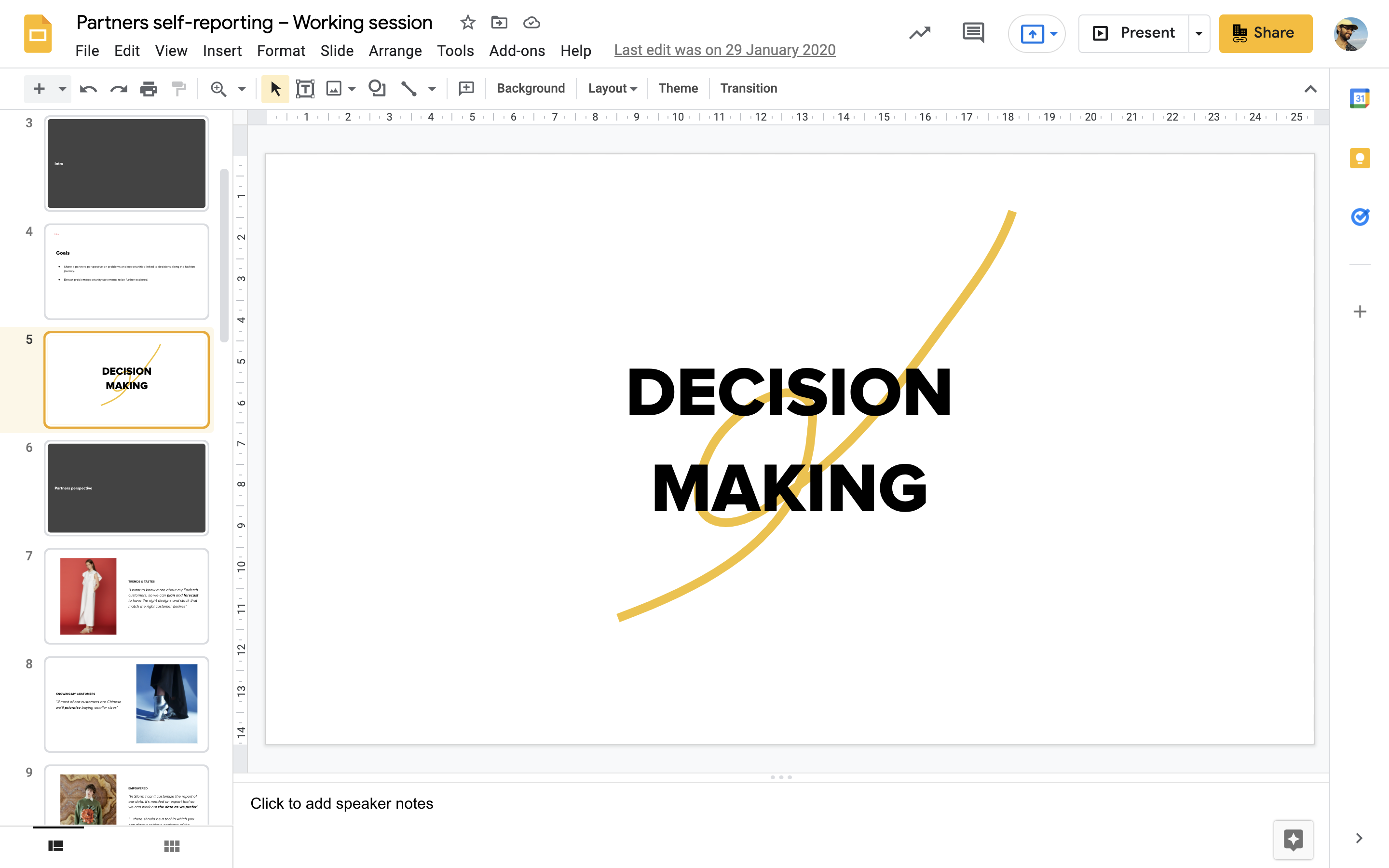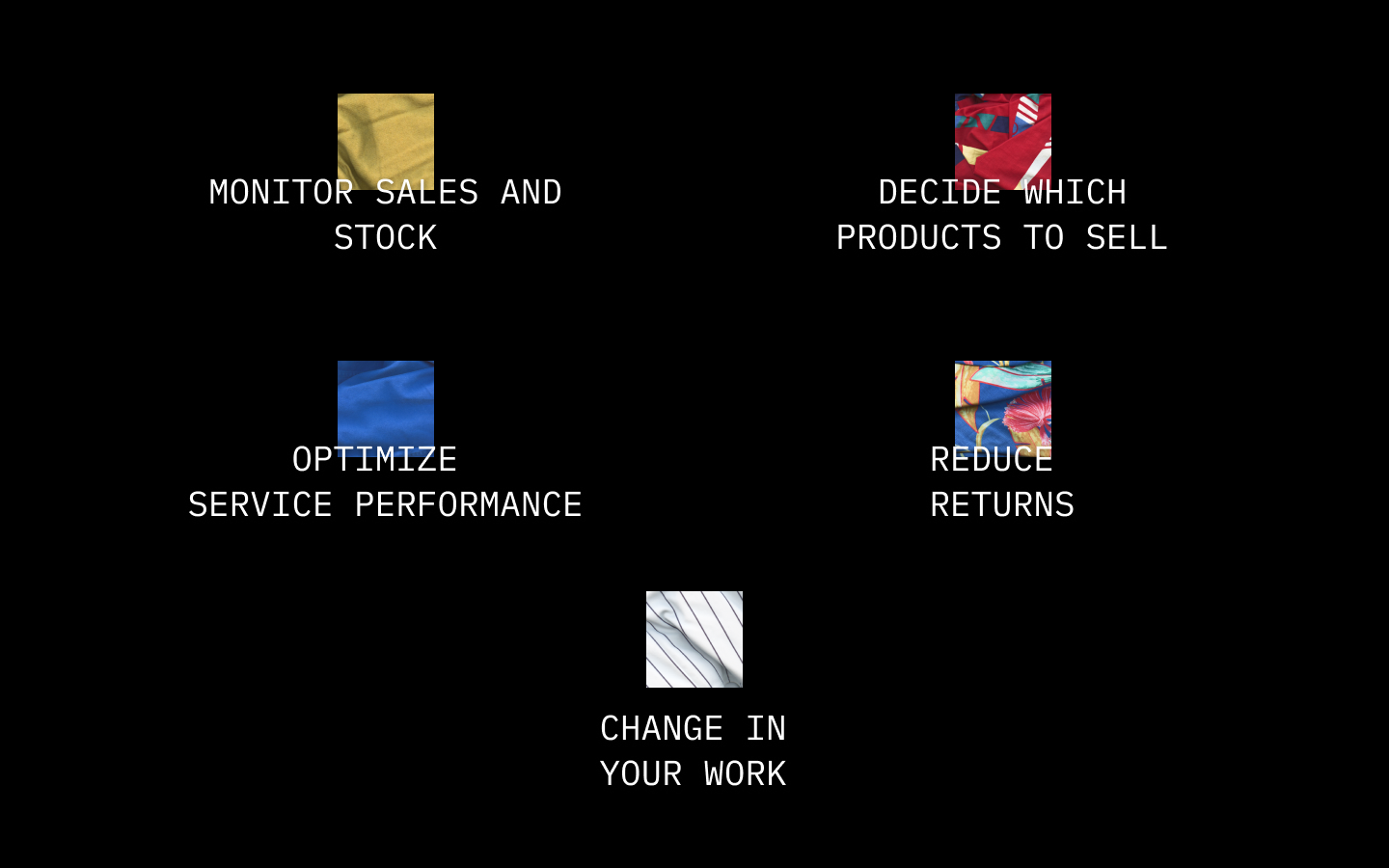SELF-SERVICE REPORTING

5min overview of the self-service reporting project
Empowering merchants to improve their business by giving them access to the right data.
Intro
For merchants selling through the Farfetch platform, understanding your performance is key to improving it. The current self-service offering for performance data does not enable them to do it efficiently, making our partners, especially on the smaller end, have to rely on manually generated reports. This creates in turn a huge effort for our partner-facing team to create and share those reports.
This project set to update our data offering to partners by bringing them the possibility to access more information about their performance by themselves. The big question being how can we help merchants take the right decisions for their business big giving them access to data.
I've led the design of this project from the time design was involved until now, where it passed the budget and will be implemented next year. We worked as a multidisciplinary team with a cast of product managers, business strategy, researchers, and internal experts on commercial and operational performance reporting. When I picked up the work, it had been started by a strategy team and phrased as a cost-saving initiative in the reduced work for internal teams building manual reports. I brought to the table the partner’s perspective, finding data that would be useful for them, and developing a revenue-generating narrative from the better business decision they could take.
We tested a concept prototype with 10 merchants, after which I made sense of the insights, presented them to stakeholders, and used them to inform the evolution of the concept. We now sliced the project into multiple deliveries, and it has been selected as the main priority for next year in my vertical.
Making data work for merchants

The workshop story was shaped to be more about informing partners' decisions than just providing metrics
When I joined the self-service reporting project, work had been already started by the ‘Partner strategy’ team. They identified the problem that too many data points were reported to partners in conflicting and mostly manually generated reports. Some self-service capacities existed, but they were so limited that partners barely used them. Only allowing to view the current month for instance. The story at the time was that we could report fewer different metrics and cover the same bases, and reduce the workload for internal teams manually producing reports.
To ensure that the solution was adopted by the merchants on the platform it had to work for them, we had to show data points that would help them take actions, not just whatever we had available. The first challenge was therefore to bring the partner's perspective to the project. To do so, we created a workshop that had for goal to make the project team look at data as tools that the merchants could use to inform their decisions along the fashion selling journey, from designing products, buying to fulfilling orders and optimising operations.
I pulled insights from existing research that related to performance reporting as well the feedback on the yearly partner survey to kick-start the activities with some of the stories we heard from partners about their need for data. We used this base and the knowledge of some partner-facing teams to identify opportunities for data alongside the selling journey and create some problem statements for specific users and contexts, like a buyer lacking the confidence to clearly access past results and current trends.
This wasn’t about defining directions that we would follow for the all project, specific partner research would be needed for that, but rather about stirring the mindset and the conversations of the team. Because solutions around specific metrics were already being discussed, we wanted to look higher than the metrics and reinforce that we need to solve a real problem for partners to make this work. It wasn’t an immediate success, there was in the group some reticence to what could feel like ‘just another post-it workshop’ and backtracking from the work that was already done. We wanted to complement the existing work and not redo it, and this message should have been clearer in the workshop introduction. It did yield results in the longer term, analysing and playing back the workshop results to the team allowed us to continue to build that conversation around data that should work for both Farfetch and merchant.

The 4 data moments we tailored the concept around, all based on the initial research. And the generic question about how this tool would change our user's work.
Data for what, data for whom
In most projects I’ve worked on, Design has to act as the balancing part between the user's needs and the stakeholder's requirements, this was particularly true in this one. Talking about performance is directly linked to what is judged as “doing good”, and on that point, our own internal teams and our partners can have conflicting views. To make a new take on self-service reporting work, it needed to be both useful for partners and in line with our commercial and operational teams strategy. A focus that made sense from the start was to target the tail end of our merchants first, those who are many but might have fewer revenues, and in turn less attention, than our bigger partners. Growing self-service capabilities in this segment is essential if we want to scale it efficiently.
To discover how those partners viewed performance reporting, our (fantastic) researcher Yuval interviewed 10 to learn about how they were using data currently. This provided incredible insights into the context in which data about performance on Farfetch were used, how they were thought of as a piece in an e-commerce all, and often synthesized by the person pulling the data before being reported up the chain of command. To complement this we did a part of internal research to understand what were the current conversations about performance reporting like, what did our internal team's messaging to partners looked like, what story did they emphasize and how were reports currently structured.
The next step for us was to define our goals for the first version and follow that with the first take on our success metrics. Collaborating with the team we tried to once against think about the actions partner could take from the data and find a way to measure that. This is where having the experience of an account manager in the team was incredibly valuable, bringing insides about the reality of retails and opportunities the product team might have not foreseen. For each metric, we wanted to increase it was important for me that we expressed the value both for Farfetch and for Partners. This was a way to reinforce that it needed to work for both parts. It’s interesting reflecting on this now, I’ve had a discussion about success metrics for this project with a PM new to it recently and we had conflicting opinions on whether to measure business metrics or adoption. To me, adoption should be measured no doubt, but what we should monitor and center the discussion around is the change that partners make to their businesses. They might not be direct, and not exist for every type of partner, but this is where the biggest impact of providing access to data lies, not just the cost-saving opportunity.
To be continued...
I'm in the middle of writing that case study but if you think that the beginning of this story was interesting, and you want to hear more about the end of it, send me an email! cle.hamon[at]gmail.com